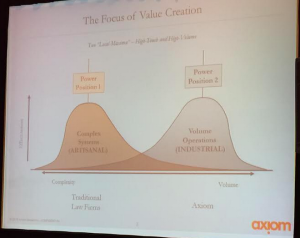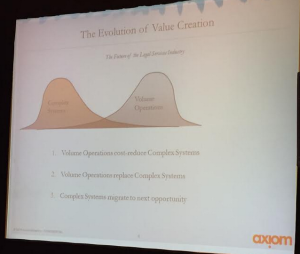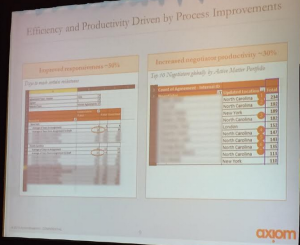This is a live blog post from the International Association for Contracting & Commercial Professionals (IACCM) Americas Forum. [Please forgive any typos or misunderstandings in meaning.]
This session is The Future of Law & Contracting (live from IACCM) with Mark Harris, Founder, Axiom and moderated by Tim Cummins President & CEO, IACCM.
The legal industry is on a transformation journey. With high volume practices, law must move from an artisanal to industrial model of doing work. How do you get to to the industrial model and what does that mean for lawyers and contracting professionals? Will come back to this.
Turn first though to the “scientific” [Mark’s word] approach to value creation. Geoffrey Moore argues that there are only two approaches to create value: (1) complex systems run by highly skilled professionals with the major process being “humanistic” and (2) volume operations run in an industrial manner where process runs on speed and minimal variation
So why does this matter? Geoff says that the rules for operating and improving and innovating in these two models are not only different but the opposite. The former embrace and harness ambiguity to convert it to advantage. Volume operations try to flush out ambiguity, which is inconsistent with the goals of volume, speed, and consistency.
Volume operators tend to arrive when novelty gives way to repetition. Mark cites as example of the first digital music licenses. The first ones were novel; today we have 1000s. The volume operator typically starts with an offer to take a portion of the complex system off the table. The latter is ok with it because it does not want that piece. In legal, that is called unbundling – and Mark says all are happy.
But the volume operator learns and gets smart over time. So think about the volume piece here as contracting systems and the complex operation as traditional contracting. Eventually the volume operator gets better and better and the end customer says “this really works for me”. The end customer does not care about how – it cares about outcomes and costs. So eventually, volume operator takes over all the work. Mark cites now Clay Christiansen work Innovator’s Dilemma. For the complex operator to survive, it has to move onto the next complex problem.
Asks audience how far to right they have moved – and how far is too far. The complex approach cannot be scaled, it can’t be audited, it can’t identify errors before they occur. With volume, in contrast, the value is in the control systems and consistency of output, to audit, to flag problems, and to leverage the “artists” (complex operators).
Mark shows outcome metrics slide from a client project that shows the industrial model crushed the complex model (this slide is hard to read even in person sitting as close to screen as possible):
The chart shows, on the left, improvement in cycle times, for example, days to first draft (a leading indicator): industrial approach was 11 days, twice as fast as 20 days of artisinal. On the right, we throughput. All incremental gains occur at zero cost if the same team / resources can do more work. At right, we see that 7 of top 10 output persons were in the industrial pilot. Moral: better compliance with industrial model leads to better outcomes.
The pilot described above started with 15 people in industrial model. Its success led to scale it to 100. This was for a bank, a compliance model, having to do with derivatives and Dodd-Frank compliance.
[Q&A not captured]
Archives
Blog Categories
- Alternative Legal Provider (44)
- Artificial Intelligence (AI) (57)
- Bar Regulation (13)
- Best Practices (39)
- Big Data and Data Science (14)
- Blockchain (10)
- Bloomberg Biz of Law Summit – Live (6)
- Business Intelligence (21)
- Contract Management (21)
- Cool Legal Conferences (13)
- COVID-19 (11)
- Design (5)
- Do Less Law (40)
- eDiscovery and Litigation Support (165)
- Experience Management (12)
- Extranets (11)
- General (194)
- Innovation and Change Management (188)
- Interesting Technology (105)
- Knowledge Management (229)
- Law Department Management (20)
- Law Departments / Client Service (120)
- Law Factory v. Bet the Farm (30)
- Law Firm Service Delivery (128)
- Law Firm Staffing (27)
- Law Libraries (6)
- Legal market survey featured (6)
- Legal Process Improvement (27)
- Legal Project Management (26)
- Legal Secretaries – Their Future (17)
- Legal Tech Start-Ups (18)
- Litigation Finance (5)
- Low Cost Law Firm Centers (22)
- Management and Technology (179)
- Notices re this Blog (10)
- Online Legal Services (64)
- Outsourcing (141)
- Personal Productivity (40)
- Roundup (58)
- Structure of Legal Business (2)
- Supplier News (13)
- Visual Intelligence (14)



